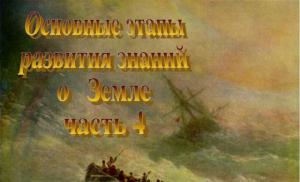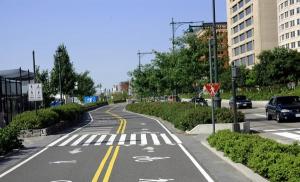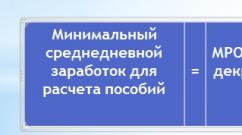Whose orders are more important than the FSB or the USSR. Who, when and why came up with the State Security Committee
On December 20, employees of the Russian special services (FSB, SVR and FSO) traditionally celebrate their professional holiday - Day of Security Agencies Worker Russian Federation. Moreover, this year they are celebrating their centennial anniversary - on December 20, 1917, on Lenin’s initiative, the Council of People’s Commissars of the RSFSR issued a Decree on the formation of the All-Russian Extraordinary Commission (VChK), which became the predecessor of the KGB and the FSB. In honor of the solemn date, the current head of the FSB, Alexander Bortnikov, gave a long interview to the editor-in-chief of Rossiyskaya Gazeta, telling how he feels about the historical past of his department and how it lives today.
According to Bortnikov, he is not embarrassed by the fact that today’s FSB employees are often called security officers, like employees of the Cheka, known for their extremely harsh methods of “fighting counter-revolution.” The head of the FSB emphasized that the activities of the current security agencies have nothing to do with the “emergency” of the first years Soviet power, but at the same time, in his opinion, “to disown the word “chekist” is the same as consigning the generations of our predecessors to oblivion.”
Answering the question of whether the security officers themselves in the 1930s did not understand that they were participating in mass repressions of innocent citizens, Bortnikov emphasized that although “among the security officers there were opportunists who adhered to the principle “the end justifies the means,” but at the same time there were and those who were motivated by selfless ideological motives." “The latter, even having come under repression themselves, for the most part did not lose faith in the party and Stalin personally,” Bortnikov noted, recalling that in 1933-1939, 22,618 security officers were subjected to repression.
Although many people associate this period of history with the mass fabrication of charges, Bortnikov noted that “archival materials indicate the presence of an objective side in a significant part of criminal cases, including those that formed the basis of well-known open trials.” Here they cited as an example “the plans of Trotsky’s supporters to remove or even liquidate Stalin and his associates in the leadership of the CPSU (b).” As Bortnikov emphasized, this “is by no means a fiction, just like the connections of the conspirators with foreign intelligence services.” "Besides, large number the defendants in those cases are representatives of the party nomenklatura and the leadership of law enforcement agencies, mired in corruption, committing arbitrariness and lynching,” the RG interlocutor recalled.
Today, Russian security agencies, changing along with society, have completely different methods, Bortnikov assured. “The domestic security agencies, having gone through a difficult path, have learned important lessons from history. Now the FSB of Russia is free from political influence and does not serve any party or group interests. It builds its work on the basis of the Constitution of Russia and federal legislation. It acts in the interests of ensuring personal security , society and state,” the head of the FSB summarized. And the results of such work by the Russian special services are increasingly supported by citizens every year, he expressed confidence.
Over five years, about 140 foreign spies and their agents were convicted in Russia
The day before, in an interview with the same Rossiyskaya Gazeta, the head of the FSB, Alexander Bortnikov, said that over the past five years in Russia people have been convicted of intelligence activities 137 personnel employees and agents foreign intelligence services. “Foreign intelligence services continue to strive to penetrate all spheres of activity of our state. Naturally, this is met with decisive rebuff from counterintelligence officers. Thus, from 2012 to the present, 137 career employees of foreign intelligence services and their agents have been convicted,” said the head of the FSB.
According to him, in cooperation with other Russian authorities, the work of 120 foreign and international non-governmental organizations, “which are an instrument of the foreign intelligence community,” was stopped. 140 people were convicted as a result of measures to protect information constituting state secrets.
According to him, Russia has repeatedly become the target of hostile attacks by foreign states, and for some, its destruction remains an obsession.
“The enemy tried to defeat us either in open battle or by relying on traitors within the country, with their help to sow confusion, divide the people, and paralyze the state’s ability to respond timely and effectively to emerging threats,” he noted.
According to the head of the FSB, security agencies must promptly identify the enemy’s plans, preempt his actions and adequately respond to any attacks.
The history of one structure: the Cheka, the GPU, the NKVD, the MGB, the KGB, the FSB, as well as the SVR, the GRU and the FSO
December 20 marks the professional holiday of employees of the Russian special services responsible for the security of individuals, society and the state - the Day of Security Agencies Worker. It was established on the basis of a decree of the President of the Russian Federation of December 20, 1995. Previously, for many decades, December 20 was celebrated unofficially as Chekist Day.
The All-Russian Extraordinary Commission for Combating Counter-Revolution and Sabotage under the Council of People's Commissars of the RSFSR was created on December 20, 1917, headed by Felix Dzerzhinsky, and abolished on February 6, 1922 with the transfer of powers to the GPU under the NKVD of the RSFSR.
The Cheka was the leading body of the “dictatorship of the proletariat” for the protection of state security of the RSFSR, “the leading body in the fight against counter-revolution throughout the entire country.” This structure was the main instrument for the implementation of the Red Terror - a set of punitive measures carried out by the Bolsheviks during the Civil War in Russia against various social groups, proclaimed class enemies, as well as against persons accused of counter-revolutionary activities. The word "chekist" comes from the abbreviation "Chka".
According to various estimates, in 1917-1922, tens of thousands of people were shot according to verdicts of revolutionary tribunals and extrajudicial sessions of the Cheka (according to other sources, up to 140 thousand).
In February 1922, at the proposal of Vladimir Lenin, the Cheka was abolished with the transfer of powers to the GPU under the NKVD of the RSFSR. In 1923, the GPU was transformed into the OGPU under the Council of People's Commissars of the USSR at the union level. In 1934, the OGPU became part of the NKVD of the USSR as the Main Directorate of State Security (GUGB).
In February 1941, the NKVD of the USSR was divided into two independent bodies: the NKVD of the USSR and the People's Commissariat of State Security (NKGB) of the USSR. In July 1941, the NKGB and the NKVD of the USSR were again united into a single People's Commissariat - the NKVD of the USSR. In April 1943, the People's Commissariat of State Security of the USSR was re-established. On March 15, 1946, the NKGB was transformed into the Ministry of State Security.
Later, the name and structural location of the department changed several more times, until in 1954 the USSR State Security Committee (KGB) was created, which worked until 1991. All this time - from 1919 to 1991, the main building of the state security bodies of the RSFSR and the USSR was the famous house on Lubyanka, built late XIX century by the insurance company "Russia", whose property was nationalized in 1918.
Since 1920, the building on Lubyanka has housed an internal state security prison, expanded in the 1930s. In connection with this, in those years they joked in Moscow that this was the tallest building in the country - Siberia and Kolyma could be seen from its basements.
On December 3, 1991, USSR President Mikhail Gorbachev signed the law “On the reorganization of state security bodies”, on the basis of which the KGB of the USSR was abolished, and for the transition period, the Inter-Republican Security Service and the Central Intelligence Service of the USSR (Foreign Intelligence Service of the Russian Federation) were created on its basis.
In January 1992, Russian President Boris Yeltsin signed a decree on the formation of the Ministry of Security of the Russian Federation on the basis of the abolished Inter-Republican Security Service and the Federal Security Agency of the RSFSR, which was transformed in November 1991 from the State Security Committee of the RSFSR, created in May of the same year.
On December 21, 1993, the President of the Russian Federation signed a decree on the abolition of the Ministry of Security and the creation of the Federal Counterintelligence Service (FSK), which, on the basis of the Russian Law of April 3, 1995 “On the Bodies of the Federal Security Service in the Russian Federation,” was transformed into the FSB.
On May 27, 1996, the Russian Federation Law “On State Security” was adopted, in accordance with which the Federal Security Service of the Russian Federation was created, which was merged in the same year with the Security Service of the President of the Russian Federation.
In 2003, the FSB of the Russian Federation transferred the functions of the abolished Federal Border Service of the Russian Federation (FBS RF) and (partially) the Federal Agency for Government Communications and Information (FAPSI) under the President of the Russian Federation. The FSB reports directly to the President of the Russian Federation.
The Federal Security Service of the Russian Federation includes departments - counterintelligence, counter-terrorism, economic security, analysis, forecast and strategic planning, organizational and personnel work; departments - military counterintelligence, constitutional security, investigative, own security, etc. Creates territorial security bodies and security bodies in the troops (special departments), together with which it forms a single centralized system of FSB bodies.
Special services also include state security agencies and their modern structure- Federal Security Service (FSO) of the Russian Federation.
The first written information about the existence of units of the grand ducal and royal guards dates back to the reign of Ivan IV (the Terrible). In the 17th century, under Tsar Alexei Mikhailovich (Romanov), boyar Artamon Matveev substantiated the need to allocate separate military, police and security (palace) functions of Streltsy regiments in the Streletsky Prikaz. At the same time, “concerns” for the protection of the royal person and family, the royal palace and the diplomatic corps were named in official documents as separate tasks separated from other Streltsy affairs. Some tasks and functions of state security, on the initiative of Matveev, were reflected in the first Russian constitutional code - the “Conciliar Code” (1649).
Then, other departments known from history were in charge of ensuring the security of the Russian state, for example, the “Preobrazhensky Order” and the Secret Office of Peter I, the Secret Expedition under the Senate, the Third Department of the Own Office of Nicholas I and Alexander II.
After the terrorist attack on March 13 (March 1, old style) 1881, when Emperor Alexander II died, the state security system in Russia was radically reformed. As a result of the transformations in September 1881, for the first time in the history of Russia, a special department was created to protect the top officials of the state. Over the next decades, the security service was improved.
Cheka (1917-1922)
The All-Russian Extraordinary Commission (VChK) was created on December 7, 1917 as an organ of the “dictatorship of the proletariat.” The main task of the commission was to fight counter-revolution and sabotage. The agency also performed the functions of intelligence, counterintelligence and political investigation. Since 1921, the tasks of the Cheka included the elimination of homelessness and neglect among children.
Chairman of the Council of People's Commissars of the USSR Vladimir Lenin called the Cheka “a devastating weapon against countless conspiracies, countless attempts on Soviet power by people who were infinitely stronger than us.”The people called the commission “the emergency”, and its employees - “chekists”. Headed the first Soviet state security agency Felix Dzerzhinsky. The building of the former mayor of Petrograd, located at Gorokhovaya, 2, was allocated for the new structure.
In February 1918, Cheka employees received the right to shoot criminals on the spot without trial or investigation in accordance with the decree “The Fatherland is in Danger!”
Capital punishment was allowed to be applied against “enemy agents, speculators, thugs, hooligans, counter-revolutionary agitators, German spies,” and later “all persons involved in White Guard organizations, conspiracies and rebellions.”
The end of the civil war and the decline of the wave of peasant uprisings made the further existence of the expanded repressive apparatus, whose activities had practically no legal restrictions, meaningless. Therefore, by 1921, the party was faced with the question of reforming the organization.
OGPU (1923-1934)
On February 6, 1922, the Cheka was finally abolished, and its powers were transferred to the State Political Administration, which later received the name United (OGPU). As Lenin emphasized: “... the abolition of the Cheka and the creation of the GPU does not simply mean changing the name of the bodies, but consists of changing the nature of the entire activity of the body during the period of peaceful construction of the state in a new situation...”.
The chairman of the department until July 20, 1926 was Felix Dzerzhinsky, after his death he took this post former People's Commissar finance Vyacheslav Menzhinsky.The main task of the new body was the same fight against counter-revolution in all its manifestations. Subordinate to the OGPU were special units of troops necessary to suppress public unrest and combat banditry.
In addition, the department was entrusted with the following functions:
- protection of railways and waterways;
- fight against smuggling and border crossing by Soviet citizens);
- carrying out special assignments of the Presidium of the All-Russian Central Executive Committee and the Council of People's Commissars.
On May 9, 1924, the powers of the OGPU were significantly expanded. The police and criminal investigation authorities began to report to the department. Thus began the process of merging state security agencies with internal affairs agencies.
NKVD (1934-1943)
July 10, 1934 was formed People's Commissariat Internal Affairs of the USSR (NKVD). The People's Commissariat was an all-Union one, and the OGPU was included in it in the form of a structural unit called the Main Directorate of State Security (GUGB). The fundamental innovation was that the judicial board of the OGPU was abolished: the new department should not have judicial functions. The new People's Commissariat headed Genrikh Yagoda.
The NKVD's area of responsibility included political investigation and the right to pass sentences out of court, the penal system, foreign intelligence, border troops, and counterintelligence in the army. In 1935, the functions of the NKVD included traffic regulation (GAI), and in 1937 NKVD departments for transport, including sea and river ports, were created.On March 28, 1937, Yagoda was arrested by the NKVD; during a search of his home, according to the protocol, pornographic photographs, Trotskyist literature and a rubber dildo were found. Due to “anti-state” activities, the Politburo of the Central Committee of the All-Union Communist Party of Bolsheviks expelled Yagoda from the party. The new head of the NKVD was appointed Nikolai Yezhov.
In 1937, the NKVD “troikas” appeared. Their commission three people handed down thousands of sentences in absentia to “enemies of the people”, based on materials from the authorities, and sometimes simply from lists. A feature of this process was the absence of protocols and the minimum number of documents on the basis of which a decision was made on the guilt of the defendant. The troika's verdict was not subject to appeal.
During the year of work by the troikas, 767,397 people were convicted, of which 386,798 people were sentenced to death. The victims most often were kulaks - wealthy peasants who did not want to voluntarily give up their property to the collective farm.
On April 10, 1939, Yezhov was arrested in his office Georgy Malenkov. Subsequently, the former head of the NKVD admitted to homosexual orientation and preparing a coup. Became the third People's Commissar of Internal Affairs Lavrenty Beria.
NKGB - MGB (1943-1954)
On February 3, 1941, the NKVD was divided into two people's commissariats - the People's Commissariat for State Security (NKGB) and the People's Commissariat for Internal Affairs (NKVD).
This was done with the aim of improving the intelligence and operational work of state security agencies and distributing the increased volume of work of the NKVD of the USSR.
The NKGB was assigned the following tasks:
- conducting intelligence work abroad;
- the fight against subversive, espionage, and terrorist activities of foreign intelligence services within the USSR;
- prompt development and elimination of the remnants of anti-Soviet parties and counter-revolutionary formations among various layers of the population of the USSR, in the system of industry, transport, communications, and agriculture;
- protection of party and government leaders.
The NKVD was entrusted with the tasks of ensuring state security. This department was in charge of military and prison units, police, and fire protection.
On July 4, 1941, in connection with the outbreak of war, it was decided to merge the NKGB and NKVD into one department in order to reduce bureaucracy.
The re-creation of the NKGB of the USSR took place in April 1943. The main task of the committee was reconnaissance and sabotage activities behind German lines. As we moved west, the importance of working in countries increased Eastern Europe, where the NKGB was engaged in the “liquidation of anti-Soviet elements.”In 1946, all people's commissariats were renamed into ministries, and accordingly, the NKGB became the USSR Ministry of State Security. At the same time he became the Minister of State Security Victor Abakumov. With his arrival, the transition of the functions of the Ministry of Internal Affairs to the jurisdiction of the MGB began. In 1947-1952, the department was transferred internal troops, police, border troops and other units (the Ministry of Internal Affairs retained camp and construction departments, fire protection, escort troops, and courier communications).
After death Stalin in 1953 Nikita Khrushchev shifted Beria and organized a campaign against illegal repression by the NKVD. Subsequently, several thousand of those unjustly convicted were rehabilitated.
KGB (1954-1991)
On March 13, 1954, the State Security Committee (KGB) was created by separating departments, services and departments related to state security issues from the MGB. Compared to its predecessors, the new body had a lower status: it was not a ministry within the government, but a committee under the government. The KGB chairman was a member of the CPSU Central Committee, but he was not a member of the highest authority - the Politburo. This was explained by the fact that the party elite wanted to protect themselves from the emergence of a new Beria - a man capable of removing her from power in order to implement his own political projects.
The area of responsibility of the new body included: foreign intelligence, counterintelligence, operational-search activities, protecting the state border of the USSR, protecting the leaders of the CPSU and the government, organizing and ensuring government communications, as well as the fight against nationalism, dissent, crime and anti-Soviet activities.
Almost immediately after its formation, the KGB carried out a large-scale staff reduction in connection with the beginning of the process of de-Stalinization of society and the state. From 1953 to 1955, state security agencies were reduced by 52%.In the 1970s, the KGB intensified its fight against dissent and the dissident movement. However, the department's actions have become more subtle and disguised. Such means of psychological pressure as surveillance, public condemnation, undermining a professional career, preventive conversations, forced travel abroad, forced confinement in psychiatric clinics, political trials, slander, lies and compromising evidence, various provocations and intimidation were actively used. At the same time, there were lists of “those not allowed to travel abroad”—those who were denied permission to travel abroad.
A new “invention” of the special services was the so-called “exile beyond the 101st kilometer”: politically unreliable citizens were evicted outside of Moscow and St. Petersburg. Under the close attention of the KGB during this period were primarily representatives of the creative intelligentsia - figures of literature, art and science - who, due to their social status and international authority, could cause the most widespread damage to the reputation of the Soviet state and the Communist Party.
In the 90s, changes in society and the system public administration USSR, caused by the processes of perestroika and glasnost, led to the need to revise the foundations and principles of the activities of state security agencies.
From 1954 to 1958, the leadership of the KGB was carried out by I. A. Serov.
From 1958 to 1961 - A. N. Shelepin.
From 1961 to 1967 - V. E. Semichastny.
From 1967 to 1982 - Yu. V. Andropov.
From May to December 1982 - V. V. Fedorchuk.
From 1982 to 1988 - V. M. Chebrikov.
From August to November 1991 - V. V. Bakatin.
December 3, 1991 President of the USSR Mikhail Gorbachev signed the law “On the reorganization of state security bodies.” Based on the document, the KGB of the USSR was abolished and, for the transition period, the Inter-Republican Security Service and the Central Intelligence Service of the USSR (currently the Foreign Intelligence Service of the Russian Federation) were created on its basis.
FSB
After the abolition of the KGB, the process of creating new state security bodies took about three years. During this time, the departments of the disbanded committee moved from one department to another.
December 21, 1993 Boris Yeltsin signed a decree on the creation of the Federal Counterintelligence Service of the Russian Federation (FSK). The director of the new body from December 1993 to March 1994 was Nikolay Golushko, and from March 1994 to June 1995 this post was held by Sergey Stepashin.
Currently, the FSB cooperates with 142 intelligence services, law enforcement agencies and border structures of 86 states. Offices of official representatives of the Service bodies operate in 45 countries.In general, the activities of the FSB bodies are carried out in the following main areas:
- counterintelligence activities;
- fight against terrorism;
- protection of the constitutional order;
- combating particularly dangerous forms of crime;
- intelligence activities;
- border activities;
- ensuring information security; fight against corruption.
The FSB was headed by:
in 1995-1996 M. I. Barsukov;
in 1996-1998 N. D. Kovalev;
in 1998-1999 V.V. Putin;
in 1999-2008 N. P. Patrushev;
since May 2008 - A. V. Bortnikov.
LENIN ABOUT VCHK
Comrades! You, of course, all know what savage hatred this institution inspires in the Russian emigration and those numerous representatives of the ruling classes of the imperialist countries who live with this Russian emigration. Of course! - this is the institution that was our devastating weapon against countless conspiracies, countless attempts on Soviet power by people who were infinitely stronger than us. They, the capitalists and landowners, had everything left in their hands international relations, all international support, they had the support of states incomparably more powerful than ours. You know from the history of these conspiracies how these people acted. You know that it was impossible to respond to them except through repression, merciless, quick, immediate, based on the sympathy of the workers and peasants. This is the dignity of our Cheka.
REPRESSIVE POLICY OF THE BOLSHEVIK GOVERNMENT
October coup d'etat, produced by the Bolshevik
party, marked the beginning of mass terror, unprecedented in the history of Russia.
We find it difficult to indicate all the punitive decrees of the Soviet government. But it's clear
that from the first days of the revolution, on orders from above, and not on initiative
"from below", shot and arrested in layers, according to class, professional or
party affiliation. So, at the end of November 1917, everyone was arrested
employees of the State Bank, and in December - all the leaders of the cadet
develop a decree “on the fight against counter-revolutionary saboteurs.” On the same
day the Cheka is created.
In Petrograd, those arrested are usually imprisoned in Kronstadt prisons,
and especially important ones - to the Peter and Paul Fortress. There is no exception
"to immediately arrest all members of the Romanian embassy and the Romanian
missions... the entire staff of employees at all institutions of the embassy,
consulates and other official Romanian institutions."
With arrests on such a grand scale, by the beginning of February
1918 Kronstadt and Petrograd prisons were overcrowded and felt
The Soviet government ordered the People's Commissariat of Justice to take
provincial prisons from one third to half of all prisoners
Petrograd. At the same time, the Council of People's Commissars amnestied part of the criminal
criminals serving sentences in Petrograd prisons, primarily for
participation in wine pogroms and banditry. Paralysis of the transport system, however,
did not give the People's Commissariat of Justice the opportunity to implement the government decree.
And the unloading of prisons was carried out in a more natural way for that time
With the help of executions.
Trotsky's leadership formed an "extraordinary commission for
food", endowed with "unlimited powers to adopt
emergency measures." The "work" of the commission led to new mass executions and
arrests. And a week later, on the 21st, due to the overcrowding of prisons and
lack of food for prisoners, the Council of People's Commissars stated that
"enemy agents, speculators... counter-revolutionary agitators (and)
German spies" will be shot by the punitive authorities of the Soviet
authorities at the crime scene. At the same time, the government created
"Extraordinary Commission for the Unloading of Petrograd."
declared Moscow under martial law and indicated that “persons caught in
where they commit a crime will be shot by detachments
revolutionary army"; "organizers of counter-revolutionary uprisings and
performances" - to submit to the "extraordinary revolutionary trial"; and
counter-revolutionary agitators - "to the court of the Moscow Revolutionary Tribunal."
On the same day, the Petrograd Cheka proposed to Moscow to form district
capital, punitive functions in Moscow were taken over by the Cheka, which moved here.
The Cheka began its activities in Moscow with mass arrests of anarchists and
internment in concentration camps of "counter-revolutionary"
prisoners of war." The attention of the government did not escape
Lenin considered the presence of arrests to be the best indicator of work. Here is the text
telegram sent by him to Tula in June “I am surprised at the lack of news.
Report urgently how much grain has been poured, how many wagons have been sent, how many
speculators and kulaks were arrested."
At the beginning of May, revolutionary tribunals were created. And in June - the first
Mass repressions fell on the right Socialist Revolutionaries and Mensheviks.
Cheka/GPU: documents and materials. Yu. G. Felshtinsky. - M.: Publishing House of Humanitarian Literature, 1995.
Presided by V. I. Lenin
9. Dzerzhinsky’s report on the organization and composition of the Commission for Combating Sabotage.
Composition (not yet complete): 1) Ksenofontov, 2) Zhidelev, 3) Averin, 4) Peterson, 5) Peters, 6) Evseev, 7) Trifonov V., 8) Dzerzhinsky, 9) Sergo? 10) Vasilievsky?
Tasks of the commission: 1) Stop and liquidate all counter-revolutionary and sabotage attempts and actions throughout Russia, no matter who they come from.
2) Bringing all saboteurs and counter-revolutionaries to trial by the Revolutionary Tribunal and developing measures to combat them.
3) The commission conducts only a preliminary investigation, since this is necessary for suppression.
The commission is divided into departments: 1) information, 2) organizational department (for organizing the fight against counter-revolution throughout Russia and branch department(s)), 3) struggle department. The commission will be finalized tomorrow. While the Liquidation Commission of the Military Revolutionary Committee is operating. The commission will pay attention first of all to the press, sabotage, cadacity, right-wing Socialist Revolutionaries, saboteur(s) and strikers. Measures - confiscation, deportation, deprivation of cards, publication of lists of enemies of the people, etc.
Resolved:
9. Name the commission - the All-Russian Extraordinary Commission under the Council of People's Commissars for Combating Counter-Revolution and Sabotage - and approve it.
V.I. Lenin and the Cheka [collection of documents (1917-1922)]. M., IPL, 1975.
FROM THE “REGULATIONS ON EMERGENCY COMMISSIONS,” ADOPTED AT THE ALL-RUSSIAN CONFERENCE OF THE EXTRAORDINARY COMMISSION ON JUNE 10, 1918
Top secret
1) At each regional, provincial, district border, etc. The Sov Depe Executive Committee or Council identifies a group of people devoted to the cause of the revolution and Soviet power, comrades who make up the Extraordinary Commission for the fight against counter-revolution and profiteering.
NOTE 1. The Chairman from among these members is appointed by the Council of Deputies, and the number of members is determined by local conditions.
NOTE 2. Where there is a regional and provincial Council of Deputies or where there are separate workers' and peasants' Councils of Deputies, one Commission should be formed there. In the first case: The commission should be under the regional Council of Deputies, which serves the province and city in which the regional Council of Deputies is located. In the second case, Chr. The commission should be organized under the Council of Workers, Red Army and Peasant Deputies.
2) Provincial Commissions are bodies of administrative power that take on the task of fighting counter-revolution and profiteering, and also stand guard over Soviet order and tranquility in their province, as well as guard the steady implementation of all orders of Soviet power.
3) The provincial and regional commissions are subordinate to the All-Russian Extraordinary Commission and report to the local Council of Deputies or the Executive Committee, the commissioners report to the provincial and regional Cheka and their executive committees. The general leadership and direction of the Commission’s work belongs to the All-Russian Extraordinary Commission.
NOTE: All circulars, orders and instructions coming from the Cheka are executed and cannot be canceled by lower authorities.
4) The tasks of the Commissions include the following:
a) A merciless fight against counter-revolution and profiteering with the available forces at the disposal of the Commission.
b) Observation of the local bourgeoisie and the direction of counter-revolutionary work among them.
c) Bringing to the attention of local and central authorities about ongoing unrest and abuses and suppressing them.
d) Conducting inquiries into state crimes.
e) Conducting research in a state of emergency.
f) Surveillance of persons traveling across the border.
g) Observation of foreign intelligence officers.
h) Search and surveillance of persons hiding from the authorities.
i) Participation in maintaining public peace in the absence of police officers and assisting the latter in restoring the broken revolutionary order.
j) Execution of orders in the highest provincial Soviet bodies to conduct inquiries into crimes, when deemed necessary.
k) Participation in some meetings necessary for the fight.
m) Monitoring and registration of all those arriving across the border and careful checking of documents for the right of entry and exit, etc.
m) Strict monitoring of the implementation of decrees and orders of the Soviet government.
5) The commission, observing and fulfilling its above-mentioned duties and strictly monitoring the normal revolutionary order in the province, taking preventive and warning measures for this in the event of any kind of counter-revolutionary uprisings, pogroms and Black Hundred riots, has the right to do the following:
a) propose to the Council of Deputies to introduce a state of emergency or martial law throughout the province;
6) issue mandatory decrees concerning the external revolutionary order in the province;
c) subject criminals to administrative arrest and impose fines in the general manner;
d) has the right to conduct searches and arrests of persons suspected of counter-revolution and generally activities directed against Soviet power.
6) The commission works in close contact with all provincial Soviet institutions and provides them with all possible assistance.
7) If abuse and omission are noticed anywhere in Soviet bodies, the Commission immediately takes appropriate measures.
8) If abuses and disorder are discovered in the Commission itself, then the provincial Council or the Executive Committee takes measures against this, up to the arrest and trial of members of the Commission.
9) The Cheka directs the work of all provincial commissions and gives them direction and helps their successful work.
10) For inaction, the Commission is responsible both to local and higher authorities, and to the Cheka.
11) Provincial commissions have the right to direct and point out the shortcomings of the external police and control its work.
12) If there are large centers in the province where Extraordinary Commissions exist, then they are subordinate to the provincial Commission, unless special instructions are received from the center.
13) From among tried and trusted comrades, the district Executive Committees appoint commissars for the same purpose in each small town, who report to the district Council of Deputies and are subordinate in their actions to the provincial Commission. The volost councils, in turn, appoint the same commissars, who are subordinate to the county commission or commissioner, and report to the volost council.
14) The duties of district and volost commissars are to monitor the revolutionary order in their area, to ensure that there is no counter-revolutionary pogrom agitation, to vigilantly monitor the local bourgeoisie, to carry out inquiries, to supervise unreliable counter-revolutionary elements, kulaks, speculators and other enemies Soviet authorities, to take preventive and warning measures against such...
Lubyanka. Cheka-OGPU-NKVD-NKGB-MGB-MVD-KGB, 1917-1960. Directory.
"Master of Lubyanka"
At the suggestion of Lenin, December 7 (20), 1917 F.E. Dzerzhinsky was appointed chairman of the All-Russian Extraordinary Commission under the Council of People's Commissars of the RSFSR to combat counter-revolution and sabotage. The Cheka and its local bodies received the broadest powers, including imposing death sentences. “The right to execute is extremely important for the Cheka,” wrote Dzerzhinsky. Being a fanatic of communism (the English spy and at the same time diplomat R.B. Lockhart wrote that Dzerzhinsky’s eyes “burned with the cold fire of fanaticism. He never blinked. His eyelids seemed paralyzed”), he created a system of suppressing opponents of Soviet power. To achieve this goal, he used any methods - both cruel (extrajudicial executions of hostages, “Red Terror” based on class principles, the creation of the first concentration camps) and softer ones (temporary isolation or deportation of dissidents abroad, etc.). His phrase “a security officer can be a person with a cool head, a warm heart and clean hands” was subsequently widely used in the USSR to characterize the image of a security officer. At the same time, in his personal life he was an ascetically modest and extremely hardworking person, completely immersed in the work assigned by the party. As M.I. Latsis recalled, Dzerzhinsky “is not content with just leadership. He himself is eager to act. And we often saw how he himself interrogated the accused and rummaged through incriminating materials. He is so captivated by the matter that he spends his nights in the premises of the Cheka. He has no time to go home. He sleeps right there, in the office behind the screen. He eats right there, the courier brings him food, which is what all Cheka employees eat.”
The first mention of such a body as the FSB of the Russian Federation appeared at the beginning of the twentieth century.
December 20, 1917 resolution of the Council of People's Commissars to combat counter-revolution and sabotage in Soviet Russia The All-Russian Extraordinary Commission (VChK) was formed. F.E. was appointed its first chairman. Dzerzhinsky. He held this post until February 6, 1922. From July to August 1918 The duties of the chairman of the Cheka were temporarily performed by Y.Kh. Peters.
In the first months of its existence, before moving to Moscow, the All-Russian Extraordinary Commission was a small institution with only 40 employees and employees. The Cheka had at its disposal a team of soldiers of the Sveaborzh regiment and a group of Red Guards. On January 14, 1918, the Council of People's Commissars instructed F.E. Dzerzhinsky to organize detachments of “energetic and ideological” sailors to combat profiteering. By the spring of 1918, the Cheka already had several detachments. In addition to the team of Sveaborzhians, she had with her a detachment of scouts, a detachment of scooter drivers, a detachment of sailors and a combat team. Abdullaev R.A. "History of state and law of Russia." - Volgograd, 2006. - P.34.
In March 1918, after moving to Moscow, the Cheka had departments: combating counter-revolution, profiteering, crimes in office, nonresident, and an information bureau. At the end of 1918-1919, the Cheka created secret operational, investigative, transport, military (special), operational, instructor departments, an information bureau and a control and audit board. At the end of 1920 and the beginning of 1921, the Cheka established an administrative, organizational, secret operational and economic management, as well as a foreign department.
After a long series of reorganizations in 1922, 1934, 1941 and 1946, through the GPU-OGPU-NKVD-NKGB-MGB-MVD, the security agencies were transformed into the State Security Committee under the Council of Ministers of the USSR. According to the then existing order, an important political decision on the separation of state security structures from the Ministry of Internal Affairs into an independent department was made by the Presidium of the CPSU Central Committee on February 8, 1954, based on a note by the USSR Minister of Internal Affairs S.N. Kruglova. Lubyanka: Bodies of the Cheka-OGPU-NKVD-NKGB-MGB-MVD-KGB // www.fsb.ru
On April 2, 1957, the KGB under the Council of Ministers of the USSR transferred border troops from the structure of the Ministry of Internal Affairs and created a Main Directorate to manage them border troops(GUPV).
Great importance was attached to preventive measures aimed at preventing state crimes. In 1967, the KGB authorities prevented 12,115 people, most of whom allowed manifestations of an anti-Soviet and politically harmful nature without hostile intent.
November 28, 1991 USSR President M.S. Gorbachev signed the Decree "On approval of the Temporary Regulations on the Inter-Republican Security Service." V.V. was appointed head of this service. Bakatin.
An interesting stage in the history of the activities of the FSB of the Russian Federation was the formation of the KGB of the RSFSR. May 6, 1991 Chairman of the Supreme Council of the RSFSR B.N. Yeltsin and Chairman of the KGB of the USSR V.A. Kryuchkov signed a protocol on the formation in accordance with the decision of the Congress of People's Deputies of Russia of the State Security Committee of the RSFSR, which has the status of a union-republican state committee. V.V. was appointed its head. Ivanenko.
On April 3, 1995, Yeltsin signed Federal law"On the bodies of the federal security service in the Russian Federation", which came into force on April 12, 1995. In accordance with it, the FSK was renamed the Federal Security Service of the Russian Federation, while no organizational and staffing measures were taken; service employees (including the director and his deputies) remained in their positions without reassignments and re-certifications. On June 23, 1995, the corresponding changes were "retrospective" number" were included in the structure of federal executive authorities. The same decree approved the regulations on the service and the structure of its central apparatus, which, with few exceptions, repeated the structure of the FSK.
In 1922, the All-Russian Central Executive Committee of the All-Union Communist Party of Bolsheviks decided to create a State Political Administration. What is GPU? Why were the Bolsheviks not satisfied with the previous punitive control body - the Cheka? We will try to answer in this article.
Reorganization of the Cheka
Before answering the question of what the GPU is, it is necessary to understand why in 1922 the VChK (All-Russian Extraordinary Commission) was no longer satisfied with party members.
The Cheka was created almost immediately after the Bolsheviks seized power. The communists themselves called this event a revolution, and in Soviet historiography it was called the “Great October Socialist Revolution.” Let us remember: in February 1917 the Great Bourgeois Revolution had already taken place. The emperor was overthrown, power was to pass to a democratic government - Constituent Assembly. However, on October 25, Lenin and his associates carried out an armed seizure of power.

Naturally, the revolutionary forces did not support such an adventurous act. The oppositionists began to be called “counter”, i.e. supporters of the counter-revolution. Subsequently, this term began to be given to everyone who at least somehow disagreed with the actions of the Bolsheviks. It was precisely to combat the “contra” that the All-Russian Extraordinary Commission was created in December 1917. It was headed by F.E. Dzerzhinsky, nicknamed “Iron Felix” for his strong character and tough disposition.

Why did the Cheka cease to suit the Bolsheviks?
The Cheka is a punitive body whose work was directed against supporters of the counter-revolution. Any citizen who showed any dissatisfaction with the current government could be declared “control.” To understand what the GPU is and how it differed from the Cheka, let us list the powers of the punitive organization. Local security officers had unlimited power. Their competence included:
- Searches at any time of the day or night without explanation.
- Arrest and interrogation of any citizen who, in the opinion of the security officers, is suspicious.
- Expropriation of property from “kulaks” and “contras” without trial or investigation. Which in practice led to total robbery.
- Detention and execution without trial or investigation.

Nobody controlled the security officers. They considered themselves “special”, who had the right to any action in the “interests of the revolution” and against the “fight against the opposition.” Thousands of ordinary citizens were shot without trial or investigation during the “Red Terror.” The security officers themselves sometimes did not even see the accused. Executions were carried out after compiling certain lists. Often the reason for reprisals was surname, appearance, occupation, etc. The Bolsheviks won civil war, so they considered repressive measures justified. Then events occurred that completely changed the consciousness of the Bolsheviks: peasants and soldiers went to war. The most famous of them is the Tambov uprising. Chemical weapons were used against the rebels, the children and wives of the partisans were sent to camps, forcing fathers and husbands to surrender. But what was truly unexpected was the uprising in Kronstadt. In fact, the force that brought them to power came out against the Bolsheviks. After this, it became clear: this could not continue.

GPU: decryption
GPU stands for Main Reorganization of the Cheka occurred on February 6, 1922. After the creation of the USSR, the OGPU - United State Political Administration - was formed in November 1923. The united structure included the GPU NKVD of the RSFSR (the main political department of the Russian Soviet Federative Socialist Republic), as well as all former organizations of the Cheka and GPU of the remaining republics. In fact, all disparate punitive authorities were included in a single and understandable management system. So, what is GPU (decoding), we have covered. Let us list the internal changes that followed the creation of this organization.
Limiting the arbitrariness of security officers
The reform significantly reduced the arbitrariness of fighters against the “contra.” The total tyranny has come to an end. Of course, local GPU officers also went too far, but this was already a violation of the law, for which punishment was expected. Even the top leaders of the security officers - Yagoda and Yezhov - were shot for arbitrariness and numerous excesses.
After the reform, the Main Political Directorate became not a punitive, but a law enforcement organization. Its competence also included the fight against enemies and spies, border protection, control over the work of the police, etc. However, now all arrests and executions were ordered by the courts, and not by crazed security officers. In addition, there was a significant reduction in local staff, and the work of employees was controlled by the prosecutor's office.

In fact, the security officers were demoted: before the reform, no one controlled them, they could do any arbitrariness “in the interests of the revolution,” and the body itself was directly subordinate to the Council of People's Commissars (Council of People's Commissars). The Cheka was higher than the NKVD. After the reform, the security officers became not a “special” unit, but policemen, since the OGPU became one of the divisions of the NKVD. A prosecutor's office was created to control the work of the new department.
Liquidation
So, we found out what GP is. Let's say a little about further reorganizations.
In 1934, the OGPU was completely liquidated as an organization. It completely merged with the NKVD. From 1934 to 1936, the organization was led by G.G. Yagoda, from 1936 to 1938 - N.I. Yezhov. And since 1938 - L.P. Beria. All of them were later shot.
In 1941, the NKVD split into the NKVD and the NKGB (People's Commissariat for State Security). The NKGB became the successor to the Cheka-GPU-OGPU.

In 1946, the NKGB was reorganized into the MGB (Ministry of State Security). After N.S. came to power. Khrushchev's MGB turns into the KGB (Committee of State Security) in 1954. It existed until the collapse of the Union. Today, the functions of the OGPU are performed by 4 departments at once: the GRU (Main Intelligence Directorate), the Investigative Committee, and the National Guard.

However, only FSB officers are considered to be the successors of the “chekists”.













